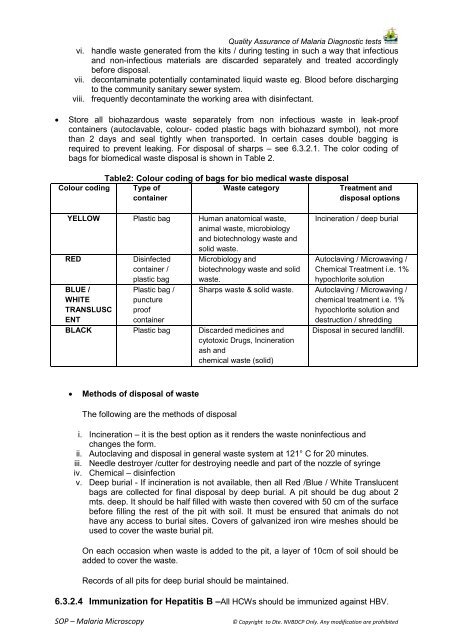SOP â Malaria Microscopy - NVBDCP
SOP â Malaria Microscopy - NVBDCP
SOP â Malaria Microscopy - NVBDCP
Create successful ePaper yourself
Turn your PDF publications into a flip-book with our unique Google optimized e-Paper software.
Quality Assurance of <strong>Malaria</strong> Diagnostic testsvi. handle waste generated from the kits / during testing in such a way that infectiousand non-infectious materials are discarded separately and treated accordinglybefore disposal.vii. decontaminate potentially contaminated liquid waste eg. Blood before dischargingto the community sanitary sewer system.viii. frequently decontaminate the working area with disinfectant.• Store all biohazardous waste separately from non infectious waste in leak-proofcontainers (autoclavable, colour- coded plastic bags with biohazard symbol), not morethan 2 days and seal tightly when transported. In certain cases double bagging isrequired to prevent leaking. For disposal of sharps – see 6.3.2.1. The color coding ofbags for biomedical waste disposal is shown in Table 2.Table2: Colour coding of bags for bio medical waste disposalColour coding Type ofcontainerWaste categoryTreatment anddisposal optionsYELLOW Plastic bag Human anatomical waste,animal waste, microbiologyand biotechnology waste andsolid waste.REDBLUE /WHITETRANSLUSCENTDisinfectedcontainer /plastic bagPlastic bag /punctureproofcontainerMicrobiology andbiotechnology waste and solidwaste.BLACK Plastic bag Discarded medicines andcytotoxic Drugs, Incinerationash andchemical waste (solid)Incineration / deep burialAutoclaving / Microwaving /Chemical Treatment i.e. 1%hypochlorite solutionSharps waste & solid waste. Autoclaving / Microwaving /chemical treatment i.e. 1%hypochlorite solution anddestruction / shreddingDisposal in secured landfill.• Methods of disposal of wasteThe following are the methods of disposali. Incineration – it is the best option as it renders the waste noninfectious andchanges the form.ii. Autoclaving and disposal in general waste system at 121° C for 20 minutes.iii. Needle destroyer /cutter for destroying needle and part of the nozzle of syringeiv. Chemical – disinfectionv. Deep burial - If incineration is not available, then all Red /Blue / White Translucentbags are collected for final disposal by deep burial. A pit should be dug about 2mts. deep. It should be half filled with waste then covered with 50 cm of the surfacebefore filling the rest of the pit with soil. It must be ensured that animals do nothave any access to burial sites. Covers of galvanized iron wire meshes should beused to cover the waste burial pit.On each occasion when waste is added to the pit, a layer of 10cm of soil should beadded to cover the waste.Records of all pits for deep burial should be maintained.6.3.2.4 Immunization for Hepatitis B –All HCWs should be immunized against HBV.<strong>SOP</strong> – <strong>Malaria</strong> <strong>Microscopy</strong>© Copyright to Dte. <strong>NVBDCP</strong> Only. Any modification are prohibited
















